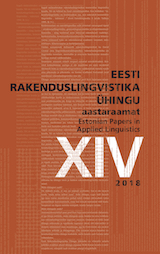MAIN-testi kasutamine eesti laste jutustamisoskuse hindamiseks
Using the Multilingual Assessment Instrument for Narratives test for the assessment of Estonian children’s narrative skills
Author(s): Andra KüttSubject(s): Lexis, Language acquisition, Comparative Linguistics, Cognitive linguistics, Methodology and research technology
Published by: Eesti Rakenduslingvistika Ühing (ERÜ)
Keywords: narrative; child language; Estonian language;
Summary/Abstract: In the Estonian language context, the Multilingual Assessment Instrument for Narratives (MAIN) has not been used for research purposes. A total of 18 children (9 boys and 9 girls) between the ages of 4 and 8 took part in trial tests: 15 Estonian mother-tongue and 3 Estonian-Russian bilingual mother-tongue children. The article was an analysis of the suitability of the test and an analysis of the test’s preliminary results in assessing Estonian children’s narrative skills. The preliminary test showed that storytelling is difficult for children. It emerged that when producing a narrative, it was not natural for children to indicate a starting point (giving time or place), but rather storytelling began immediately with a conflict and goal as internal components. Challenges and goals also turned out to be the most common and therefore the simplest content in the children’s narratives. There was little complexity in the children’s narratives, and most presented individual goals without conflicts or outcomes. Least common was all three macrostructural components (goal-conflict-outcome) in succession in the children’s stories. Stories that achieved higher scores in production were also more complex and these displayed components and sequencing of components that show the cohesion and completeness of the work. Stories that achieved lower scores rather contain individual goals of narrative production, but with conflicts and outcomes to a lesser extent. In the Estonian children’s narratives, there were few words referring to a person’s inner feelings or reactions. The results showed that Estonian children find it difficult to use emotion words, which is evidenced by their limited use of IST words (including emotion words) as well as their null-rated understanding of the internal reactions and states of individuals. No connection emerged showing that those that narrate better also understand better. A high comprehension test result shows that the test stimulus, a series of pictures, was understood and the test turned out to be appropriate for the children. Better narrators generally have a richer vocabulary and children with a richer vocabulary express more internal reactions and conditions of individuals in their stories. By analysing the density of the vocabulary used by the children in their narratives and its relationship with points in the narrative, it became clear that a child’s more varied vocabulary is not connected to better narrative skills. For further research purposes, this test has significant added value and research focus which provides an opportunity to link narrative production skills with studies of the developmental environment.
Journal: Eesti Rakenduslingvistika Ühingu aastaraamat
- Issue Year: 2018
- Issue No: 14
- Page Range: 95-115
- Page Count: 21
- Language: Estonian

